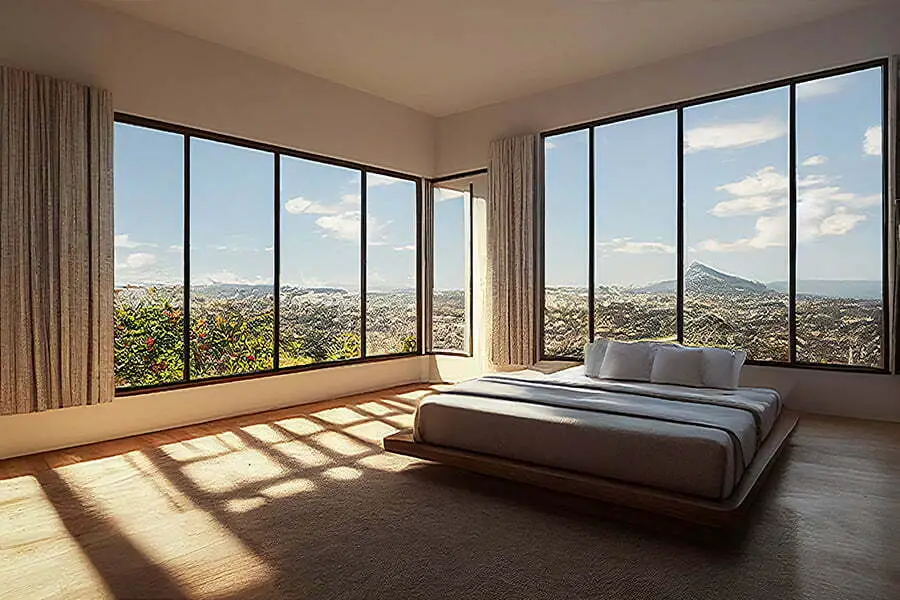Let’s explore how to strike the perfect balance between windows and thermal comfort in your home.
One chilly winter evening, I found myself sitting on my couch wrapped in a blanket with the heater blasting, yet still feeling a draft coming from my windows.
It was then that I realized just how crucial it is to have high-quality windows that not only look great but also provide optimal thermal comfort.
That experience led me down a rabbit hole of researching everything there is to know about windows and thermal insulation. From double-pane glass to low-emissivity coatings, I learned all about the different options available for homeowners looking to improve their home’s energy efficiency while maintaining maximum comfort.
In this blog post, we’ll dive into the world of windows and explore how you can strike the perfect balance between thermal comfort and energy efficiency in your own home.
Understanding Thermal Comfort

When it comes to creating a comfortable living space, temperature is one of the most important factors. But what exactly is thermal comfort? In simple terms, it refers to the state of mind that expresses satisfaction with the surrounding environment’s thermal conditions.
Achieving optimal thermal comfort in your home means maintaining a consistent and comfortable indoor temperature throughout all seasons.
As I continued my research on windows and insulation, I discovered that achieving this balance can be challenging without proper knowledge or guidance. Many homeowners make the mistake of solely focusing on energy efficiency when selecting windows for their homes while neglecting their family’s overall comfort.
However, choosing high-quality windows designed specifically for maximum thermal performance can significantly improve your home’s overall energy efficiency while ensuring you remain cozy during those chilly winter nights.
So how do you strike this perfect balance between energy efficiency and optimal thermal comfort? Let’s dive into some key considerations when selecting new windows for your home!
Window Types and Insulation

There are a variety of types and insulation options available. From single-pane to double-pane glass, each type has its own unique benefits and drawbacks.
After my chilly evening on the couch, I decided to upgrade my home’s windows with double-pane glass. This type of window features two panes of glass separated by an insulating layer that helps reduce heat transfer between the inside and outside of your home.
But even within the realm of double-pane windows, there are different levels of insulation available. Some feature low-emissivity coatings that help reflect heat back into your home during colder months while keeping unwanted solar radiation out during warmer months.
It’s important to consider both the climate in which you live as well as your personal preferences when choosing a window type and level of insulation for optimal thermal comfort in your home. By doing so, you can strike that perfect balance between energy efficiency and coziness all year round!
Energy-efficient Windows

After my experience with the drafty windows, I knew that energy-efficient windows were a must-have for my home. These types of windows are designed to reduce heat loss and gain, which can help lower your energy bills and improve thermal comfort in your home.
One popular option for energy-efficient windows is double-pane glass. This type of window has two panes of glass separated by an insulating gas like argon or krypton.
The space between the panes helps to reduce heat transfer through the window, making it more efficient at keeping warm air inside during winter months.
Another option is low-emissivity (low-e) coatings on the glass surface. These coatings reflect infrared radiation from both inside and outside your home while still allowing visible light to pass through.
This means that you can enjoy natural light without sacrificing thermal comfort or increasing your energy bills.
When choosing new windows for your home, be sure to look for those with an ENERGY STAR® rating as they meet strict guidelines set by the U.S Environmental Protection Agency (EPA).
By investing in high-quality, energy-efficient windows you’ll not only save money on heating and cooling costs but also increase overall comfort levels within your living space – something we all want!
Balancing Natural Light

Balancing natural light is just as important as finding the right insulation. Natural light not only brightens up a room but also has numerous health benefits such as improving mood and boosting vitamin D levels.
However, too much sunlight can lead to uncomfortable heat buildup in your home during the summer months. That’s where window treatments come into play.
Options like blinds or shades allow you to control the amount of natural light entering your home while still maintaining privacy. Another option for maximizing natural light without sacrificing energy efficiency is installing windows with low-emissivity coatings (also known as Low-E glass).
These coatings help reduce solar heat gain by reflecting infrared radiation from the sun while still allowing visible light to pass through. When it comes down to it, striking a balance between natural lighting and thermal comfort requires careful consideration of both aesthetics and functionality.
But with so many options available on today’s market, achieving that perfect balance has never been easier!
Ventilation and Airflow

When it comes to achieving optimal thermal comfort in your home, ventilation and airflow play a crucial role. Proper ventilation not only helps regulate the temperature but also improves indoor air quality by reducing humidity levels and removing pollutants.
There are several types of window designs that can improve airflow in your home. For instance, casement windows open outward from the side like a door and create an unobstructed flow of fresh air into your space.
Similarly, awning windows open upward from the bottom to allow for natural convection currents to circulate warm air out while drawing cool air inside.
However, it’s important to note that while proper ventilation is essential for maintaining thermal comfort in your home, too much or too little can have adverse effects on energy efficiency. That’s why finding the right balance between adequate airflow and insulation is key when selecting new windows for your home.
When choosing new windows for improved thermal comfort at home; consider how different window designs affect ventilation & airflow as well as energy efficiency before making any decisions!
Window Treatments for Comfort

One of the most effective ways to improve thermal comfort in your home is by investing in window treatments. Not only do they add a decorative touch to your windows, but they also provide an extra layer of insulation that can help regulate the temperature inside.
After my chilly evening on the couch, I decided to invest in some new window treatments for my living room windows. I opted for thick curtains with a thermal lining that not only looked great but also helped keep out drafts and retain heat during colder months.
But it’s not just about keeping warm during winter – window treatments can also help keep you cool during hot summer months. Lighter-colored shades or blinds with reflective coatings can reflect sunlight and prevent excess heat from entering your home.
When choosing window treatments for comfort, it’s important to consider both style and function. Look for options that complement your decor while providing optimal insulation properties based on climate conditions where you live.
By adding high-quality window treatments as part of our overall strategy towards achieving maximum thermal comfort at home, we’re able to enjoy cozy evenings without worrying about energy bills skyrocketing!
Seasonal Adjustments

As the seasons change, so do our heating and cooling needs. During the winter months, we rely on our heating systems to keep us warm and cozy indoors.
However, if your windows are not properly insulated or sealed, you may find yourself constantly adjusting your thermostat in an attempt to maintain a comfortable temperature.
On the other hand, during summer months when temperatures rise outside, it’s important that your windows allow for proper ventilation without letting in too much heat from outside. This is where seasonal adjustments come into play.
By making small adjustments throughout the year such as adding insulating curtains or blinds during winter months and opening windows strategically during summer days/nights can help you strike that perfect balance between thermal comfort and energy efficiency all year round.
It’s important to note that these seasonal adjustments will vary depending on where you live geographically – what works for someone living in Florida might not work for someone living in Maine! So be sure to research what strategies work best based on your location before making any changes.
By taking into account both thermal comfort needs as well as energy efficiency concerns when selecting window treatments/adjustments throughout each season of the year homeowners can ensure they’re striking a perfect balance between staying comfortable while also saving money on their utility bills!
Recap




